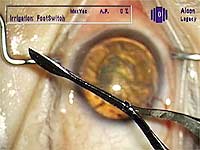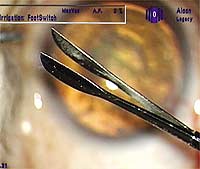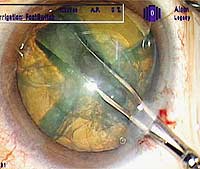Cataract prechopper facilitates microincision surgery while reducing phaco energy, time
To reduce stress on ciliary zonules and the capsular bag, a nucleus manipulator should support harder nuclei while the prechopper is inserted.
 View of the Akahoshi Micro Combo Prechopper with the blade in the closed position.  View of the Akahoshi Micro Combo Prechopper with the blades in the open position.  The Akahoshi Micro Combo Prechopper being inserted into a cataractous nucleus through a 1.5-mm side-port incision.  The Akahoshi Micro Combo Prechopper completing nuclear division of a cataract into four pieces. (All images courtesy of Takayuki Akahoshi, MD.) |
TOKYO — A new cataract prechopper allows nuclear dissection through a microincision and reduces overall phacoemulsification time and energy, according to the instrument’s designer.
Takayuki Akahoshi, MD, director of ophthalmology at Mitsui Memorial Hospital here, told Ocular Surgery News the Akahoshi Micro Combo Prechopper (ASICO AE-4285) is used to divide the nucleus under viscoelastic material prior to phaco. In contrast to conventional prechoppers, which employ a cross-action mechanism designed to be used through the main surgical incision, the Micro Combo Prechopper uses a pin and rocker mechanism and can be inserted through a side-port incision.
Dr. Akahoshi said surgeons can attain the same nuclear division using the Micro Combo Prechopper as with existing prechoppers. In addition to the reduction in phaco time and energy, breaking up the nucleus before phaco significantly reduces mechanical and thermal stress on the side-port incision.
“I believe cataract surgery should be performed most efficiently with minimal invasion,” Dr. Akahoshi said. “To perform phaco surgery through the smallest incision most efficiently, this microphaco prechop technique will be a most useful technique to reduce the required ultrasound energy. It is a great advantage for laser phaco or sleeveless bimanual microincision phaco techniques.”
He noted that one drawback to performing microincision surgery is the lack of an appropriate IOL for implanting through the microincision.
“I prefer conventional phaco because no IOL is available in Japan for implanting through a 1.5-mm microincision, and bimanual phaco requires longer surgical time than conventional phaco,” he said.
However, he said prechopping shortens ultrasound time as well as total surgical time in both bimanual and conventional phaco.
“I prefer to use a single-piece AcrySof SA60AT or SN60AT (Alcon) to implant with an injector system. I mainly perform conventional phaco through a 3-mm incision using the new Akahoshi tip (Alcon) with an irrigation sleeve. It is much faster and easy to perform,” Dr. Akahoshi said.
Pearls for prechopping
In using the Micro Combo Prechopper, Dr. Akahoshi said a complete capsulorrhexis is first made, followed by sufficient hydrodissection through a side-port incision. After filling the anterior chamber with viscoelastic material, the Micro Combo Prechopper is inserted through the 1.5-mm side-port incision.
The goal of the prechopping procedure is complete nuclear division from the top to the bottom of the nucleus and from the proximal end to the distal end.
For prechopping soft nuclei — cataracts of grade 1 or grade 2 — the angular edge of the blade is placed centrally and inserted directly into the core of the nucleus. Squeezing on the prechopper handles opens the prechopper blades and bisects the nucleus without compromising the wound.
Dr. Akahoshi said the rounded side of the blade can safely be used close to the posterior capsule for completing nuclear division. Rotating the nucleus 90° allows each bisected nuclear fragment to again be prechopped in the same way.
For prechopping nuclei grade 3 or harder, Dr. Akahoshi said he uses a nucleus manipulator (ASICO AE-2536) to support the nucleus, which reduces stress on the ciliary zonules and capsular bag while the prechopper blade is inserted. He said that with the nucleus properly supported, even hard, grade 5 cataracts can be prechopped using the counter-prechop technique. Soft nuclei, such as grade 1 or grade 2, can be prechopped with the prechopper alone.
In using the Micro Combo Prechopper, Dr. Akahoshi said it is important to make a complete capsulorrhexis without tears or notches, and to perform sufficient hydrodissection so the nucleus can rotate freely in the capsular bag.
To attain a complete nuclear division, he said the rounded side of the prechopper blade can be used safely close to the posterior capsule because of the blunt finish on its rounded side. He reiterated that soft nuclei can be prechopped using the prechopper alone. However, in cases involving harder nuclei, weak ciliary zonules or an incomplete capsulorrhexis, the nucleus should be supported by a second instrument to reduce the stress on the ciliary zonules and capsular bags.
Reduced time
Dr. Akahoshi said the time required to prechop a nucleus will depend on the hardness of the cataract. Compared to bimanual microincision phaco surgery without prechopping, he said the surgical time will be markedly reduced.
“It may be less than half [as long] in my cases. As most of the surgical time is spent performing phaco in bimanual phaco surgery, the total surgical time will be markedly affected by a microincision prechop technique,” he said.
Dr. Akahoshi said it takes less than a minute for him to prechop softer nuclei of grade 1 or 2. Nuclei harder than grade 3 require prechopping using the counter-prechop technique and usually take between 1 and 2 minutes.
Cases with soft nuclei will require 2 to 3 minutes total surgery time to remove the nucleus. However, Dr. Akahoshi noted actual ultrasound time will be less 30 seconds if a pulse mode of 15 pulses per second is used and less than 6 seconds by the 30-msec short burst mode.
| Akahoshi Micro Combo Prechopper characteristics |
Source: T. Akahoshi, MD |
For Your Information:
- Takayuki Akahoshi, MD, is Director of Ophthalmology, Mitsui Memorial Hospital. He can be reached at Mitsui Memorial Hospital, Chiyodaku, Tokyo, 101-8643, Japan; +(81) 3-3862-9111; fax: +(81) 3-5821-2446; e-mail: eye@bg.wakwak.com. Dr. Akahoshi has no direct financial interest in the products mentioned in this article, nor is he a paid consultant for any companies mentioned.
- American Surgical Instruments Corporation (ASICO), makers of the Akahoshi Micro Combo Prechopper (AE-4285), can be reached at 26 Plaza Drive, Westmont, IL 60559 U.S.A.; +(1) 630-986-8032; fax: +(1) 630-986-0065; e-mail: info@asico.com; Web site: www.asico.com.
